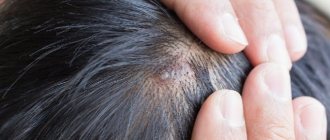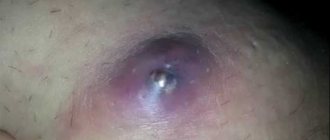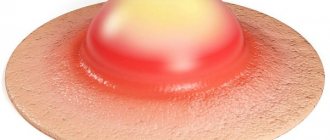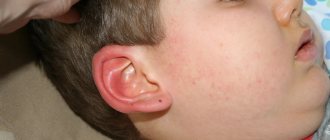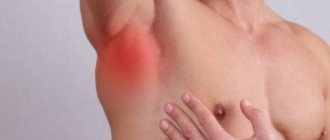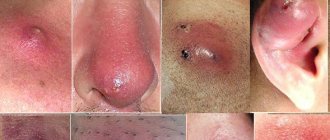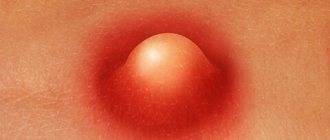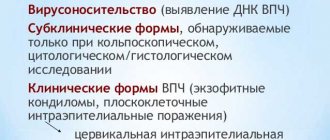Boils on the butt have appeared in many people, since regardless of age and gender, this pathology can develop in everyone. For some reasons, patients do not want to contact a specialist for help in a timely manner; meanwhile, the boil matures, itches, and an inflamed area forms.
If you treat a boil at home incorrectly, there is a risk of infection and complicating the situation. The specific localization of the boil - on the butt - brings considerable discomfort to the patient, as it causes pain, and difficulties arise when treating the outbreak. If you leave the situation without treatment, complications arise, so you should immediately consult a doctor.
The disease occurs due to the entry of Staphylococcus aureus into the hair follicles and their subsequent inflammation. Pus collects inside, a core forms and then a boil breaks out. If there are two or more boils on the body, we are talking about furunculosis. Let's take a closer look at the causes, symptoms and methods of treating a boil on the buttocks at home and with medications.
Reasons for appearance
A boil in the gluteal region in most cases occurs as a result of the harmful effects of Staphylococcus aureus .
Less commonly, the disease is caused by other pathogenic bacteria - streptococci, Pseudomonas aeruginosa, Proteus vulgaris.
These microorganisms live on human skin, but cannot cause harm as long as the body's defenses resist them. The integrity of the skin and the beneficial microflora that live on it prevent the penetration of pathogens.
But under certain conditions, harmful bacteria can become active and provoke the development of pustular diseases. Weakened immunity is the main risk factor.
The immune system fails as a result of:
- physical fatigue, emotional or mental stress;
- long-term use of antibacterial and hormonal drugs;
- excessive enthusiasm for diets;
- chronic stress.
The pathogen penetrates the hair follicle and begins to actively multiply. Neighboring sebaceous glands and subcutaneous fat tissue are affected. In abscesses on the buttocks, pus always forms - this is the result of bacterial activity.
Boils cannot occur on areas of the body that lack hair follicles (the soles and palms of the hands).
Common locations for boils are on the face, thighs, tailbone, between the buttocks, near the anus.
Boils occur more often in men; one of the factors predisposing to the disease is the presence of a larger number of hair follicles than in women and girls.
The reasons for the formation of boils on the buttock can be:
- past infectious diseases;
- diseases of the digestive tract;
- pathologies of the endocrine system;
- intoxication of the body;
- hormonal changes;
- avitaminosis;
- temperature changes;
- poor personal hygiene – a mixture of sweat and dirt creates favorable conditions for bacterial activity;
- irritation of the skin, including near the anus, due to wearing tight clothes and underwear made of synthetic fabrics;
- skin damage - cuts, abrasions, scratches, cracks;
- skin sensitivity and tendency to irritation;
- from a psychosomatic point of view, the development of the disease is provoked by negative emotions, stress and depressive states.
Precautionary measures
If an internal inflamed boil with an accumulation of purulent mass is detected, squeezing it out is unacceptable . Such manipulation can cause the infection to spread to healthy skin. You should only perform any manipulations with boils with clean hands. Moreover, it is recommended to carefully treat them with antibacterial agents after contact with a purulent neoplasm, this prevents the spread of infection throughout the body.
In order to reduce pain, it is recommended to treat boils formed on the buttocks with dry heat. For this purpose, special lamps are used in medical offices.
The process of restoration of damaged epidermis is shortened if the purulent formation is isolated from external irritants by a patch that has a protective effect. The problematic pimple and the skin adjacent to it are regularly rinsed and treated with antiseptics. In this way, the spread of a dangerous pathogen throughout the body is prevented.
Since boils appear and actively develop due to a weakened immune system, it is worth paying attention to your daily diet. Regular consumption of spicy, fatty, fried foods, fast food upsets the balance of vitamins and essential microelements, impairs natural protective functions, so it is better to avoid such food.
Symptoms
The formation of boils on the butt is accompanied by characteristic symptoms:
- itching and local redness appear in the affected area. The spot is dense, quite painful, especially when pressed;
- the focus of inflammation quickly increases in size, the tissues in this place are hot, compacted, and swollen. The general condition of the patient is deteriorating - weakness, headache, high temperature. Painful sensations intensify;
- a purulent core forms in the center of the lesion, which can reach a diameter of up to 2 cm. The abscess makes itself felt by pulsating and shooting pains;
- within a few days the boil matures and opens. Pus comes out of the cavity, then the rod is rejected. Swelling decreases, pain decreases, temperature reaches normal;
- At the site of the boil, a fairly deep ulcer forms, which heals within 5 to 7 days. But the indented scar may remain for a long time.
What choice of shampoo for seborrheic dermatitis do manufacturers offer? An overview of effective means is presented in this material.
If you are interested in how chickenpox starts in children, read this article.
Differential diagnosis
A boil can be diagnosed by its stages of maturation:
- infiltration,
- suppuration,
- abscess formation.
First, a hair follicle forms on the inflamed area. During this period, numbness may be felt, which is accompanied by an unpleasant tingling sensation.
During the period of suppuration, a red tubercle appears on the skin surface, quickly increasing in size.
During the abscess formation stage, a white head appears in the center of the boil - an abscess. After a few days, the boil decreases in size, and the pus begins to gradually come out.
What does a boil on the buttock look like (photo)
Antibiotics
After examining the culture for microflora, the patient may be prescribed antibiotics. They have the greatest effect in treating boils on the butt. But they must be prescribed by the attending physician. The specialist may prescribe to the patient:
- Oxacillin. You need to take the antibiotic 3 grams per day an hour before meals. The course of treatment is 7-10 days.
- Erythromycin. This drug, unlike Oxacillin, does not destroy bacteria, but slows down their growth. Therefore, it is prescribed for elevated temperatures and ripening boils on the buttocks. Adults need to take the drug 20-50 mg per kilogram of weight once a day for 10 days.
Treatment with antibiotics must be a continuous course.
Stages of maturation
The boil development process lasts on average about 10 days, sometimes up to 2 weeks. The maturation of a boil occurs in several stages or stages:
- At the infiltration stage, a red spot forms around the hair follicle, painful when pressed. The boundaries of the spot increase, neighboring tissues swell. Swelling is most pronounced if the boil appears on the lips, eyelids, or cheek.
- From the moment the boil forms until the stage of suppuration and necrosis begins, 3 to 5 days pass. The diameter of the boil can reach 3 cm; a rod with a white head at the end appears in the center. The skin around the abscess is smooth, shiny, dense. The clinical picture of the disease is complemented by symptoms of general intoxication - malaise, feeling of weakness, fever, lack of appetite. When the boil opens, purulent contents flow out of it and the rod separates. The patient's health begins to improve quickly.
- Healing is the final stage in the development of a boil on the buttocks. In place of the boil, a kind of crater is formed, which heals within 3–4 days. After this, a noticeable scar forms there (its color is blue-red), but gradually it becomes paler and merges with the skin.
Preventive measures
The effectiveness of treatment depends on prevention. It is imperative to maintain personal hygiene, especially if a person is prone to excessive sweating. While following a diet, do not forget about taking vitamin and mineral complexes.
You should try to avoid hypothermia. If you find a boil on your buttocks, it is strictly forbidden to squeeze it out. This will cause serious complications.
It is advisable to design the diet so that it contains as much plant food and fiber as possible. The consumption of animal fats should be abandoned or their consumption significantly limited. Also, once a year you can take a course of taking immunostimulating drugs based on medicinal herbs and plants. Following these recommendations, you can forget about boils on the buttocks.
How to treat a boil on the butt
It is best to treat a boil on the buttocks under the supervision of a doctor to speed up the process and avoid unwanted complications. This is especially true when an internal boil forms.
You can start treatment at home as soon as the first symptoms of inflammation appear. The area of the boil that is forming must be treated with iodine.
This product has disinfectant properties and is able to penetrate deep into tissues, fighting inflammatory processes.
At an early stage, the source of inflammation can be treated with a swab soaked in medical alcohol, hydrogen peroxide, or boric alcohol.
After applying the antiseptic, the boil is covered with a sterile bandage and the bandage is secured with an adhesive plaster.
It happens that with timely, thorough treatment of the skin, it is possible to prevent the development of furunculosis.
To speed up the maturation of the abscess, bandages are applied to the sore spot:
- with Vishnevsky ointment, which helps abscesses to ripen and come out faster;
- ichthyol ointment, which promotes the release of pus;
- Levomekol is used both at the stage of ripening boils and at the stage of their healing.
Dressings with medicinal ointments are changed several times a day. Before applying them, the skin is treated with salicylic alcohol, chlorhexidine, and hydrogen peroxide.
We wrote more thoroughly about stretching ointments here.
Regarding the application of dry heat to a boil at an early stage of its formation, this should be done with great caution.
Heat can trigger the spread of the pathological process into the deep subcutaneous layers and adipose tissue.
You cannot get rid of boils by squeezing them out. The infection can easily spread to neighboring tissues.
While the boil is maturing, it is forbidden to take showers or hot baths. After opening boils, wounds should not be wetted.
Antibiotics are prescribed if the boils are large and difficult to treat. The following drugs are used (they are taken in tablets, and also administered intramuscularly and intravenously):
- Oxycillin;
- Erythromycin;
- Lincomycin;
- Cephalexin;
- Fucidin;
- Amoxiclav.
When the pus has already begun to drain, the use of a hypertonic solution of table salt can help clean the wound.
2 teaspoons should be dissolved in a glass of warm water, moisten a napkin in the solution and apply it to the inflamed area.
The healing of wounds after the opening of boils and the release of pus is facilitated by products containing antibiotics. We wrote in detail about antibiotics here.
You can anoint the sore spot with the following ointments:
- Tetracycline;
- Erythromycin;
- Levomekol;
- Baneocin;
- Oflocaine;
- Bactroban;
- Bondermom.
If boils are persistent, the cause should be sought in decreased immunity. In this case, immunomodulating therapy, the use of antibiotics, and correction of concomitant diseases are prescribed.
Boils in an adult are treated with ultraviolet radiation; several procedures are enough to eliminate this pathology.
Patients often have a desire to squeeze out the boil, but this should not be done. It is difficult to ensure complete sterility at home, but it is very easy to introduce additional infections.
Surgical treatment of boils is used if conservative therapy has failed. Large abscesses deep in the tissue are treated by opening the abscess, removing its contents and applying a bandage. We wrote about this in more detail here.
Contractubex is used to soften and resolve scars. This drug contains components that promote the healing of skin defects.
In what cases is self-medication unacceptable:
- if ulcers are found on the child’s buttocks. This is fraught with serious complications, since the development of pathological processes in children occurs very quickly;
- in case of formation of boils in the perianal area or in the rectum;
- when the general condition worsens and pain in the affected area increases.
Localization
Boils can appear on any part of the body where there is hair. They do not appear on the palms and soles of the feet. But more often they occur in the buttocks, shoulders and face.
Purulent abscesses pose a serious danger if they are located on the face and between the buttocks. When localized in this way, boils can interfere with normal bowel movements and are difficult to treat on your own.
If treated incorrectly, this will lead to the spread of rashes to the genitals, which are actively supplied with blood. It is better to consult a doctor about how to treat a boil between the buttocks. This will prevent unpleasant consequences.
Folk remedies for treating chiryak at home
It is problematic to remove boils using folk remedies alone, but in complex therapy of the disease their use is quite acceptable.
Chiryak is treated at home with onions, garlic, honey, agave, and black bread. They help draw out pus, treat inflammation, relieve pain, and heal wounds.
Here are some of the commonly used folk recipes:
- For the whole night, apply a compress of honey, mixed with flour until dough thick, and animal fat (duck, goose, pork are suitable) to the wound.
- Apply a mixture of honey, butter and laundry soap shavings to the sore spot. All ingredients are taken in equal proportions. Cover the top with film, insulate and leave for several hours.
- Chop the garlic, wrap the mass in a cloth soaked in sunflower oil, and fix it on the wound. Change the compress 2 times a day. This remedy helps draw out the pus from the boil without burning the skin.
- Wrap the crushed aloe leaf in a sterile bandage, apply to the boil and leave for 5 – 6 hours.
- To speed up the release of purulent contents, apply half a baked onion to the boil; such applications are repeated every 3 hours.
- To wash already opened abscesses, use saline solutions (take a full teaspoon of salt per glass of water - sea salt is better, but regular table salt can also be used).
We discussed the issue of home treatment for boils in detail in this publication.
This material provides instructions for using Emolium body emulsion.
Instructions for using Sinaflan ointment are discussed in detail in this publication.
Symptoms and treatment of pyoderma in children are described here: https://udermatologa.com/zabol/pio/simptomy-i-lechenie-piodermii-u-detey-i-vzroslyh/
Prevention
The appearance of a boil is a signal from the body that the immune system is insufficient. This means that you need to support your body as much as possible in the fight against infection. To prevent purulent processes from recurring, you need to:
- Eat healthy at approximately the same time every day;
- Temper yourself, adhering to the rule of gradualness;
- Eat foods rich in vitamins C, A, E;
- It is rational to alternate work and rest;
- Be in the fresh air more often;
- Increase physical activity (gymnastics, aerobics, gym);
- Avoid stressful situations.
If boils pop up often and are severe, then it is worth undergoing treatment in a hospital. Perhaps there it will be possible to eliminate the causes of such an unpleasant condition.
Source: otekam.net
What can it lead to?
The danger of such a pathology as boils should not be underestimated. If the sore is injured, the purulent capsule may collapse and the infection will spread to the internal tissues.
Toxic substances produced by the causative agents of boils (mainly staphylococci) poison the body, provoke allergic reactions and can contribute to the development of autoimmune diseases.
The action of pathogens leads to the occurrence of furunculosis - that is, relapses of ulcers that will occur constantly. Further, the pathology can develop into carbunculosis - a more complex form of pustular skin disease, more about this here.
What other dangerous consequences can a boil on the buttocks cause:
- if the suppuration is severe, then the infection threatens to penetrate the nearby lymph nodes, causing lymphadenitis. There is also a risk of developing lymphangitis - inflammation of the lymphatic vessels;
- a boil on the anus is fraught with proctitis (inflammation of the walls of the rectum) or an anal fistula;
- untimely treatment of a boil can lead to its transformation, when a phlegmon or abscess forms at the site of the lesion;
- The development of sepsis, with damage to vital organs, is also possible. This disease can be fatal.
Complications that appear
If there is no timely treatment for chiria, barley on the butt, the purulent process from the affected follicle spreads to adjacent healthy areas. This is how furunculosis develops (numerous appearance of ulcers). If effective therapeutic measures are not taken, sepsis (blood poisoning) is highly likely to occur.
There are situations when, after the boil has matured, the purulent exudate does not come out, but enters the lymphatic channel, contributing to the development of additional infections in the form of lymphadenitis or lymphangitis. The penetration of staphylococcus into the bloodstream is dangerous, which can lead to disruption of the functions of internal organs and systems.
